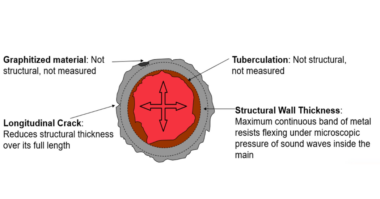Around the world there is a growing need for increased access to drinkable water with sustainability of supply. Systems that rely on large centralized water supply and treatment facilities cannot meet the current or future demand, and in such large scale systems opportunities for innovation is often limited by perceived technical, financial and organizational difficulties. Progress has been seen in the development of systems where localized water supply and treatment plants are set up in an interlinked network that is better able to respond to the changing demands of individual communities and pressures on supply; these are economically more efficient, reduce the impact on natural water systems and are more resilient to natural disasters. Innovation can be more easily tested at a local level with reduced financial and technical risk.
The increasing demands put on water supplies mean that natural systems are more vulnerable to long-term degradation or system failure, with potentially catastrophic effects on communities. The sustainability of resources and efficiency of supplyare therefore critical issues. The development of localized water treatment systems can encourage a wider pool of innovation, which will inevitably have a positive impact on social and economic development. Technological innovation is therefore an essential part of any future plan for the development of water supplies.
One of the United Nations’ eight Millennium Development Goals is to ensure environmental sustainability, which includes the target of halving the proportion of the population without access to safe drinking water and basic sanitation by 2015. In World Bank client countries, access to improved water supply rose from 73% in 1990 to 86.4% in 2010. The World Bank has financed projects that emphasize financial and environmental stability; it has championed Integrated Urban Water Management (IUWM) which views water supply as part of a given landscape, where competition for a resource such as a river basin requires an integrated and flexible management plan that allows for a complex set of challenges to be met. A typical example can be seen in South Sudan, where in a short period of time, in an immediate post-war environment, approximately 402,500 people became direct beneficiaries of improved water supply and sanitation. The plan included the construction or repair of 568 water points, the establishment of a Water Committee with 4,340 newly trained members, 9 water quality laboratories and one rural training institution.
Advantages of a localized network
With a series of local water supply systems operating in parallel, the constraint of continuous running of the system is eliminated, making it easier and safer to take any one unit off-line for repair or upgrade. Adding more small scale units to the system may mean additional training and the necessity of a wider pool of expertise, but the organization as a whole will benefit from economies of scope and scale, where functioning across a wider area means a reduction in costs as the number of similar systems increases. The interests and welfare of local populations are more easily satisfied by a localized supply; issues of public liability are also more readily addressed. As these localized supplies proliferate, communities are able to tailor their water treatment to specific local uses, separating out the supply given over to industrial, agricultural and residential use or for energy production, and avoiding the drawback of a centralized supply where communities are forced to treat all water as standard regardless of use. Varied treatments at the point of use can significantly improve the cost effectiveness of the system. The needs of geographically diverse areas can be met, taking into account the specifics of rainfall, temperature and evaporation rates, as well as the interdependence of local social, political, infrastructure and environmental systems, which will require different water treatments.
Integrated Water Resource Management (IWRM) views each water source – whether surface, ground or waste water – and the demands put upon each from different sectors, as a pyramidal structure of supply and end use, with domestic use representing the small but most important apex of the system. High water use in one area can impact on availability in another. An improved IWMR can be a means of resolving conflict. IWMR follows the Dublin Principles, which were formulated at the 1992 Dublin National Conference on Water and Environment, in short: that water is a finite and vulnerable resource; that water management should be based on a participatory approach; that women play a central part in provision, management and safeguarding of water; and that water has an economic value and should be recognized as an economic good.
Innovation in water treatment
Innovations continue to be made in pump technology, water supply systems, business models and approaches to management that put localized water treatment in the forefront of the developing utilities sector. New filtration technologies such as polymeric micro-membranes and ultra-filtration systems can now filter water to a matter of a few microns, which is small enough to exclude most bacteria. These reduce operation costs as they require minimal hands-on operation and reduced chemical consumption. In the long term, developments in the technology of nanoparticles andnanomembranes promises advances in the direct treatment of specific contaminants.
New disinfection systems using ultrasound or the visible light spectrum are being developed. In April 2013 the Dutch company Advanced Waste Solutions B.V. completed testing of the ‘Lazur’ system of water and sewage disinfection, which is based on ultraviolet irradiation with an ultrasound pre-treatment. Studies by University of Science and Technology Beijing have shown promising results: ‘…these experiments clearly show that the proposal of using ultrasound to pre-treat waste water could be a very attractive alternative to enhance ultraviolet disinfect efficiency.’
Ultraviolet light treatment combined with an innovative business model with up-front capital financing has already been used successfully by Water Health International in many countries around the world, including India, the Philippines, Sri Lanka and Mexico. Communities that did not have piped water but relied on water delivery trucks filling individual household containers are now able to take advantage of newly established ‘water stores’ and new water distribution management systems.
Decentralized supply combined with innovation in monitoring systems that give real-time information about water quality, quantity and flow rates, and an effective partnering of industry, public agencies and NGOs, is achieving an effective balance between direct use and resource management. Regional monitoring and control can ensure that the needs of individual communities are met while maintaining the viability of natural resources.




Excellent article Melissa! The good news is that investment in system upgrades is growing, but unfortunately may never return to historic levels; even though its estimated that 65% more water will be consumed [W/ WW] by 2025. Recent statistics show that there are 700 main breaks per day on the East coast and that 1 in 6 gallons is lost [est. value $50B) and that ironically the replacement/ upgrade cycle is not sufficient; less than the life cycle of pipes etc. which means in general transportation pipes will fail again before replacement. Lets hope that the effectiveness of the upstream activity you discussed above helps offset some of the loss seen downstream through poorly maintained water transportation systems. The good news is that many companies are focusing on water conservation which will in some way help to offset the other areas of water loss
Again I very much enjoyed reading your article!